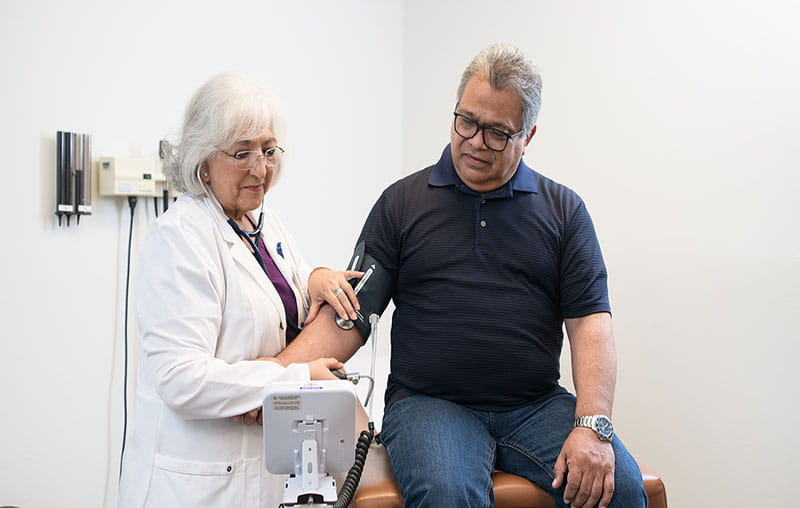The heart develops in stages throughout pregnancy, with the four chambers of the heart developing eight weeks after conception. Sometimes, however, a congenital heart defect occurs where parts of the heart do not develop properly.
Tetralogy of Fallot is one such congenital heart defect, and it’s considered complex. There are four (tetra) findings with tetralogy of Fallot:
- Ventricular septal defect, an opening in the wall between the two ventricles
- Overriding aorta, causing the aorta to shift from the left side of the heart to the right side
- Narrowing of the pulmonary artery, which carries blood between the heart and the lungs
- Enlargement of the right ventricle
These defects, if unrepaired, can cause:
- Low oxygen levels in the blood
- Delayed growth
- Shortened life expectancy
Because of this, tetralogy of Fallot is categorized as a “critical” congenital heart defect requiring open heart surgery and a lifelong cardiology follow-up. These children will likely need more interventions (surgery or catheter-based procedures) for the blood pathway to the lungs.
Diagnosis and Evaluation
Tetralogy of Fallot is diagnosed either during pregnancy or after birth. It can sometimes be detected during a routine prenatal ultrasound and then a fetal echocardiogram follows to confirm the diagnosis.
After birth, tetralogy of Fallot is often diagnosed by the presence of a murmur or a low oxygen saturation (cyanosis), prompting an echo for confirmation. Signs such as bluish skin or a heart murmur can indicate to a medical provider that tetralogy of Fallot is present. In some cases, newborn pulse oximetry testing may identify low oxygen levels before symptoms occur.
A newborn or young infant can have “tet spells” episodes of turning blue (cyanosis) when crying or eating.
A pediatric cardiologist will use certain tests to confirm the diagnosis (most often an echo and a chest X-ray). For more complex cases of tetralogy of Fallot, a cardiac CT or MRI may be needed.
Treatment Options for Tetralogy of Fallot
For children diagnosed with tetralogy of Fallot, surgery is a necessary part of treatment. In most cases, babies undergo a first surgical procedure around 3-6 months of age. Nearly all children with the defect undergo surgery by 12 months.
Some newborns with severe tetralogy of Fallot may first undergo a procedure to place a shunt from the aorta into the pulmonary artery. This small tube helps to stabilize blood flow between the heart and lungs allowing the baby to grow more before surgery. If possible, a similar procedure can be performed in the cath lab.
Surgical Procedure Details
Before Surgery
In the time before surgery, babies with tetralogy of Fallot get treatment to maximize blood flow to the lungs, including:
- Hydration
- Blood counts
- Medications to slow the heart rate
- Avoidance of excess stimulation
In the days and weeks prior to surgery, testing is performed to ensure the child is healthy enough to undergo surgery. Parents are provided a list of instructions about preparing for surgery.
Day of Surgery
On the day of surgery, surgeons correct the heart defects. During the procedure, the pulmonary valve will be addressed and, in some cases, removed. The right ventricular outflow tract will also be enlarged by removing excess heart muscle and enlarging the pulmonary arteries using a patch. Another patch is used to close the ventricular septal defect.
These repairs allow oxygen-poor blood to move smoothly from the heart to the lungs.
Recovery and Postoperative Care
After surgery, children first recover in an intensive care unit, where their vital signs can be carefully monitored. In most cases, patients are discharged from the hospital after around one week, though a longer stay may be needed.
It can take several weeks to months to fully recover following tetralogy of Fallot surgery, depending on the severity of defects and the complexity of the procedure. During this time, children may be easily fatigued and sleep more than usual.
Appetite and growth are typically normal for children shortly after surgery.
Regular visits with a pediatric cardiologist following tetralogy of Fallot surgery are important for maintaining good health and making any necessary adjustments to a child’s routine and lifestyle.
Prognosis and Long-Term Outcomes
The vast majority of patients experience a positive outcome following tetralogy of Fallot repair. A 2019 study found that the overall survival rate was 94.5%at the 20-year mark following surgery. Outcomes can vary depending on the specifics of a child’s defect.
In many cases, children will require additional surgical repairs or other treatment during their life. This may include pulmonary valve replacement surgery to lower the risk of heart complications, such as abnormal heart rhythms and heart failure.
It’s important for those who have had tetralogy of Fallot surgery to follow up with a cardiologist for life and transition from a pediatric cardiologist to a congenital heart defect specialist. This specialized provider offers guidance about necessary care, such as prophylactic antibiotics prior to surgery or dental procedures to prevent heart infections and counseling for women of childbearing age.
Patients with repaired tetralogy of Fallot can live long, full lives with the help of early treatment and follow-up care. Notable people with this defect include Shaun White and Jimmy Kimmel’s son, Billy.
Fetal Heart Care at University Health
Learn more about fetal heart care at University Health in San Antonio.





